Do you want to know why you’re not losing fat, like, for real? You’re eating too much.
Yup.
Even when you think you aren’t. Even when you think you’re eating “healthy”, even when you’re exercising hard, even when you think you’re “hardly eating”, and yes, even despite reading this and getting pissed at me for telling you you’re wrong.
The fact remains: you’re not losing body fat because in one way or another, whether you realise it or not: you’re eating more than you think are even when you think you aren’t.
And in the next six-thousand-motherfucking-words, I’m going to be explaining and showing you exactly how and why.
Let’s play a quick game
The rules are easy. I’m going to list several food items below and all you have to do is guess the rough calorie count in each one, cool? Good. Let’s begin.
- A medium-sized tub of cinema popcorn.
- A large pepperoni pizza.
- 1 tablespoon of peanut butter.
- A Grande Caffe Mocha from Starbucks.
- A Big Mac Meal.
You can check how close you were with the answers in the footnotes. Remember your answers because we’re going to come back to them.
But, first. We’re taking a small diversion from our regularly scheduled programming because until we don’t get these myths out of the way: we’re not going anywhere.
Starvation Mode and Slow Metabolisms. OH MY!
I’m supposed to write an epigrammatic lead here–but I can’t be bothered. So let’s just pretend I did. Oh, and let’s also pretend it was funny and you laughed.
Starvation Mode
Starvation Mode is this wacky idea that if you eat too little an amount of calories for an extended period of time your body stops burning fat; in fact, it starts doing the opposite–you start gaining weight ‘even when consuming 800 calories’. Sound familiar?
So, how much truth is there to this?
Well, see, Starvation Mode is an odd one. Because, while it’s not entirely correct, it’s not entirely incorrect either.
- The correct part: When you reduce calories, more specifically as you begin to get leaner, there is, in fact, some slowing of metabolic rate.
- The incorrect part: Due to this low-calorie consumption your body decides fuck you and proceeds to enter this phantom zone of otherworldliness where the laws of thermodynamics cease to exist, resulting in no fat loss, or worse, gaining fat on some absurdly low number of calories.
What’s really going on: As you start to lose body fat (and weight), there’s less of you. This ‘lessness’ means your body doesn’t require as many calories to keep you alive.
Let me explain it like this: look at the circle below. Let’s assume for the sake of illustration this circle serves a purpose. And for it to serve this purpose, it requires energy which is represented by the smaller circles inside.
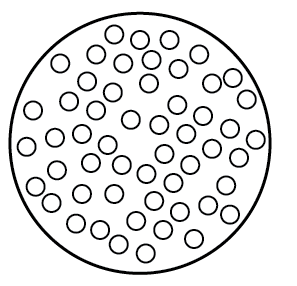
If we decrease the size of the circle, it won’t require as much energy as it’s former, larger self. So, it’s only logical we reduce the amount of energy it now requires by removing some of the circles inside.
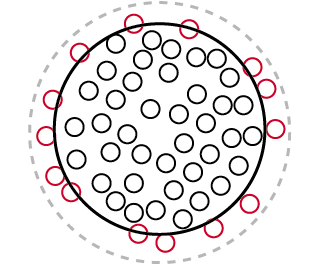
Now, the same circle is requiring less energy to keep it running. If we continue to reduce the size of the circle, we also need to remove more of the smaller circles inside as it doesn’t require as much energy to keep it running.
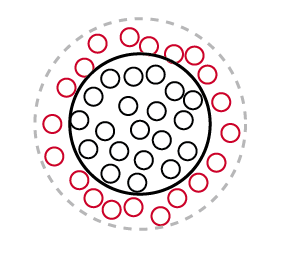
A similar process happens with the body: as you start to get leaner, your body requires fewer calories (energy) to keep it running than when you were, uh, more fluffy. The leaner and lighter you become the fewer calories your body requires to keep you alive and functioning.
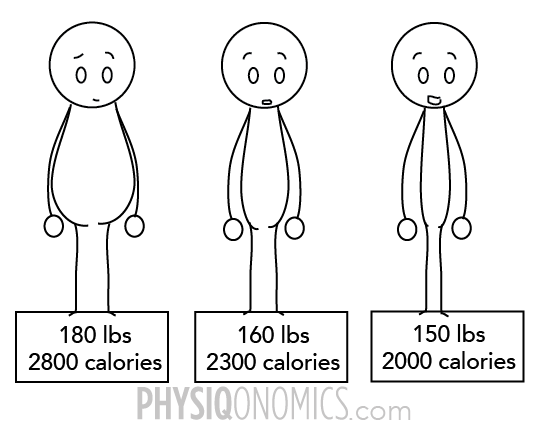
This process is referred to as adaptive thermogenesis and as the name implies, the metabolism has adapted to the lower energy requirements of your new lighter, leaner self.
As I mentioned in this article, the metabolism consists of a few different components: RMR [this is your actual metabolism], AEE, and TEF. And no, I’m not going to detail what all of these are again, go read the article.
Studies have shown that even when people have lost huge amounts of weight, the actual change in their basal metabolic rate is around ~10%-15%.
The majority of the reduction in metabolism comes from decreases in the physical components like NEAT. Simply, people begin to move around less.
Let me show you what actual starvation looks like.
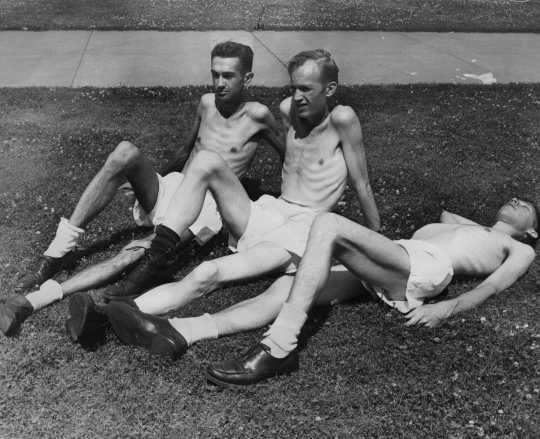
You see those three dudes above that look like they just straight popped out of Michael Jackson’s Thriller video?
They’re three of thirty-six men from the famous Minnesota Starvation Experiment. The experiment was done to investigate the physiological and psychological effects of severe starvation.
Let me explain what they did.
36 men were put on a 24-week long starvation diet, consisting of two meals per day at a total of 1560 calories. Their calorie intake was reduced further throughout the study to keep weight loss happening.
On top of the crazy calorie intake, they were also expected to walk or run 22 miles (36 kilometres) every week.
This was about a 50% deficit. To add some perspective, general guidelines for even the most aggressive fat loss protocols are 20-25%; this was twice that amount.
Let that sink in for a second. I’ll wait.
Ok, let’s continue.
All the men lost about 25% of their total body weight and ended up around 5% body fat.
By the end of the study, the men’s metabolic rates dropped by about 40%. Once again, their actual RMR only dropped by around ~15%.
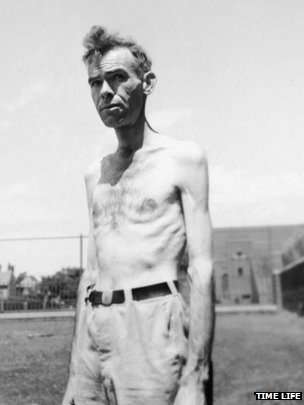
Look at the photo above, now go look at yourself in the mirror: Unless you look like the emaciated dude above, you’re not in Starvation Mode.
Let’s address this logically: If there was this bizarre, incorporeal force stopping people from losing weight because they were eating too little, then you see the 21,000 people who die from hunger every day? Yeah, they wouldn’t.
Your metabolism has simply adapted to your new, lighter, body weight.
So, then, uh…if I’m not in starvation mode: what’s going on?
Hold up, I’ll get to that in a second. We still need to take a look at one more thing…
The ‘slow metabolism’
I wrote damn near an essay on the last point so I’m keeping this short.
You don’t have a slow metabolism. Let’s move on.
No, seriously, we’re moving on. If you want to learn about why the slow metabolism idea is nonsense, read this.
Health concerns?
There can be some medical conditions that can impact weight loss. The most prominent one being hypothyroidism. This is outside my scope of practice and all I’m allowed to say is: if you suspect this to be the case, i.e you read through this whole article, and everything is in order–go see a doctor and get your thyroid checked out.
So if you aren’t in starvation mode and you don’t have a slow metabolism: What exactly is going on?
There are two factors at play here.
- Misreporting Intake
- Calorie Ignorance
Misreporting Intake
Let’s go back to the game we played earlier. Remember your answers? How close were you? If you’re like most people, probably a bit more off than you thought, right?
This simple exercise was intended to get you to stop and think about how many calories these foods contain because the truth is, people are notoriously bad– no, really, like super bad–at reporting calorie intake.
This isn’t an opinion, either, it’s a fact. There are a plethora of studies that have shown this over and over and over and over and over, over, over, over again…and again.
Misreporting of food intake isn’t exclusive to the general public, either. Here’s a review of a study by James Krieger of Weightology finding that even dietitians misreport calorie intake.
The results showed that the dietitians underreported their food intake by an average of 223 calories per day, while the non-dietitians underreported their intake by an average of 429 calories per day. Thus, while being a dietitian improves the accuracy of self-report of food intake, it does not eliminate the phenomena of underreporting.
Yes, even people whose job involves dealing with these things on a daily basis aren’t immune to the error.
Let me show you one more thing.
This British actress was adamant she had a slow metabolism, turned out she was simply misreporting calorie intake.
When she recorded her food intake via video journal, her intake, according to her, was 1100 calories. When they checked her actual intake (with doubly labelled water) it came to 3000 calories.
Even when she was keeping a food diary, she misreported by 43%.
Numbers are abstract. Let’s make this palpable.
Let’s say your calorie intake is 1500 calories: 43% is 645 calories. Maybe within the scope of a day or two, this wouldn’t make that much of a difference, but you misreport like this over a week? That’s an additional +3500 calories you ‘forgot’ about – enough to gain a pound of fat.
Suffice to say, I’ve made my point. People are terrible at tracking and reporting food intake accurately.
Calorie Ignorance
People are grossly unaware of not only how many calories they’re eating, but what a calorie even is.
As Marion Nestle put it:
People have a vague idea that calories have something to do with putting on weight, but little intuitive grasp of the number in foods or what they do in the body
And this is the problem. When you’re not paying attention to calorie intake you’ve left yourself open to all the environmental and cognitive factors that have you eating more and more without even realising.
On that note…
The Obesogenic Environment and Cognitive Errors
As I’m about to show you, there are a host of environmental and cognitive factors at play and If you’re not being calorie conscious you’re going to have a hard time either losing weight or controlling your weight, even when you’re eating healthy, cutting out junk, exercising, and ‘hardly eating’.
Note that throughout the article I use the term ‘calorie-conscious’. You don’t have to be super neurotic with calorie tracking but having some semblance of calorie intake helps. How meticulous you wish to be will depend on your goals and circumstances.
The Environment
Let’s journey back a few thousand years. No, a bit further. There we go.
Life is drastically different than what we’re used to now. Most prominent being there are no fast-food restaurants, takeaways, or supermarkets everywhere. Food is extremely scarce and the only way for us to have food is to get out and work to produce it.
Fast-forwarding a few hundred years and we hit the industrial revolution: bringing with it the boom in technology and mechanisation. With this boom came increased abundance and easy access to food. We no longer had to go and find or work for food: our food started coming to us. Thanks, Uber.
But it doesn’t stop there. Not only do we have easy access to food, the food itself isn’t exactly helping.
Calorie Density
Have you ever looked at a food item, then seen the calorie count and thought ‘No way can that have those many calories’?
Well, it can and it does. This is because food today is ‘calorie-dense’: Calorie density refers to the number of calories relative to the weight and size of the food. Fruits and vegetables have a low-calorie density, while heavily processed foods like chocolate bars, cakes, doughnuts have a high-calorie density.
Let’s look at an example. A large apple weighs around 220g and has 110 calories. One Krispy Kreme Original Doughnut weighs 52g but packs a massive 220 calories.
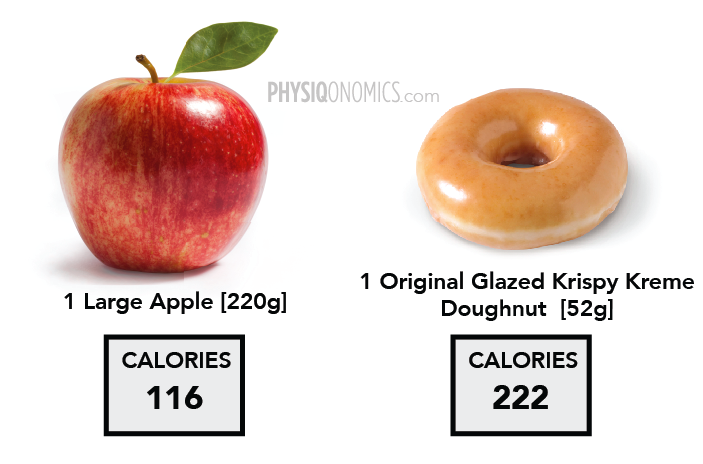
In the modern food environment, foods are becoming smaller but containing two, three, four, and more times the number of calories for their size.
Solution: Most of the modern-day calorie-tracking apps like MyFitnessPal are pretty accurate with the calorie counts. As long as you’re tracking these calorie-dense foods, feel free to enjoy them as part of a nutrient-rich diet. The only time I would limit the intake of these foods is during a low-calorie phase, like when dieting, where low-calorie dense foods like fruits and veggies will help keep you satiated and not take a chunk out of your calorie total.
Food Palatability
‘Hyper-palatable foods’ is the fancy term for ‘it tastes fucking good’, and is the combination of sugar, fat and salt in the right amounts—also known as the ‘bliss point’.
While the media will try to convince you that sugar is the devil incarnate, it isn’t sugar on its own that drives the ‘reward response’. Have you ever binged on table sugar? Exactly. It’s the combination of sugar, fat, and salt that make foods ‘hyper-palatable’ and drives us to want and eat more.
Typical quote-unquote junk foods such as ice cream, pop tarts, cookies, cake, pizza are the quintessence of hyper-rewarding foods.
When we consume hyper-palatable foods they light up a series of mechanisms in our brain collectively referred to as ‘the reward response system’ which makes us want to consume more of said food. This is the same system that lights up when people take drugs, drink alcohol, and have sex.
Food hyper-palatability encourages us to eat more and drives us to keep eating more, even when we feel full.
Dr David Kessler perfectly summed up this response in his book, The End of Overeating:
The food environment provides so much food designed deliberately to excite pleasure centers that it overrides biological stop signals. The factors that discourage calorie intake and promote satiety ought to function quite well in environments that encourage the consumption of diets high in nutrient density and low in calorie density. But in food environments that aggressively promote overconsumption of high-calorie foods, the ‘’eat more’’ signals overpower those that promote satiety. In such environments, matters largely beyond personal control are remarkably effective at overcoming physiological regulatory mechanisms
Solution: If you find you have certain foods that trigger you to overeat, don’t eat or keep these foods in the house. The more you decrease your exposure to these foods, the more likely you are to succeed with your diet. Studies suggest when people reduce the palatability of the diet, they’re more likely to succeed and keep the weight off in the long-term.
All of these factors have culminated in what we now call the obesogenic environment.
Through years of evolution, the goal has been to eat as much as possible when food was available, with the goal of packing on as much fat as possible, and then wait out the winter when food was scarce and hard to come by.
Compare that to today, where food is in constant supply, easy to access, and unnaturally delicious–throw in our decreasing activity levels, and you have the perfect formula for rapid fat gain.
This isn’t to say that fat gain is inevitable, and that exercising and eating well is pointless. In fact, quite the opposite, in all the research we have on successful dieters that have maintained weight in the long term, exercise and being calorie conscious were two key habits.
Cognitive Errors
The environment is only one-half of the problem. The second half is not external, but internal and takes place in your mind.
These cognitive errors can be just as, if not more insidious to our waistlines than the environment around us. The bad news? Most people don’t even realise they’re committing these. The good news? By the end of this article, you will.
The Health Halo Effect of Food
The “Health Halo” effect of food is when consumers believe foods that are advertised as healthier have fewer calories, and then compensate by eating more of these healthier foods which then leads to additional calories consumed.
Here’s a video clip from popular UK TV show “Secret Eaters” showcasing the Halo Effect.
The woman can be seen liberally pouring olive oil over several meals. When she’s shown the video she replies, ‘but I thought olive oil was good for you?’
The dietitian made her aware that ‘over the course of surveillance you got through 2000 calories of just olive oil, which works out to around 460 calories a day. If you use this amount of oil on a daily basis, over the course of a month that’s the same amount of calories as 1.8 kilograms of butter.’
You can see her face screw up in horror as the dietitian’s last sentence hits her. This is the health halo effect of food in full effect. We assume because a food item is ‘healthy’ we can eat more of it.
Here are some more examples of where the Health Halo Effect pops up.
• Fruit Juices
You see those 100%, natural, organic, freshly picked, and squeezed by the hands of an angel, fruit juices, yeah? Let’s talk about them. This is what a serving (200ml) of orange juice looks like
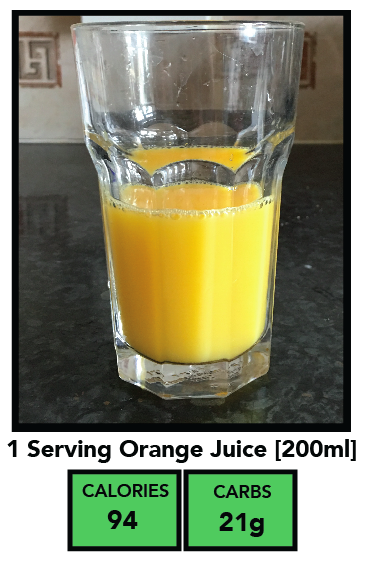
Now, I’m not sure about you, but I’ve never seen someone drink an actual serving. Most people are going to be filling that glass to the top. This is a full glass of OJ, coming in at 350 ml.
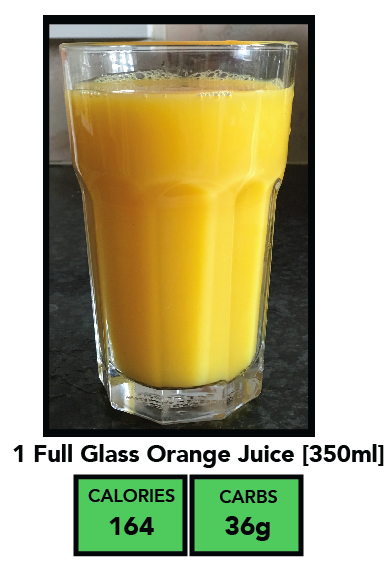
But, even 350ml is less than the standard sized bottles you find in stores. The smallest size you’ll find most fruit juices is 500ml bottles.
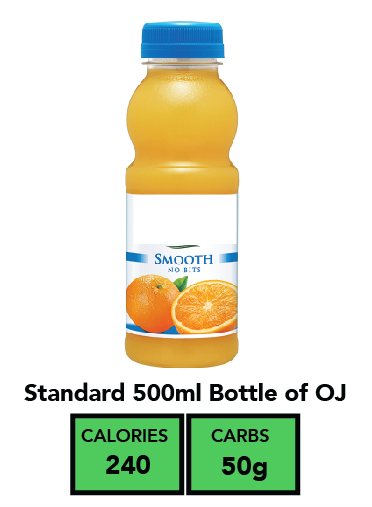
If you drink two of those 500ml bottles in a day because you think it’s ‘healthy’: you’re looking at almost 500 calories. Even if they’re labelled ‘100% natural’ and contain vitamins and minerals, the calories still count and they add up. Fast. Especially as juices aren’t satiating like their whole food alternative, so you’ll drink more, and in turn consume more calories.
Compare this to eating an actual orange.
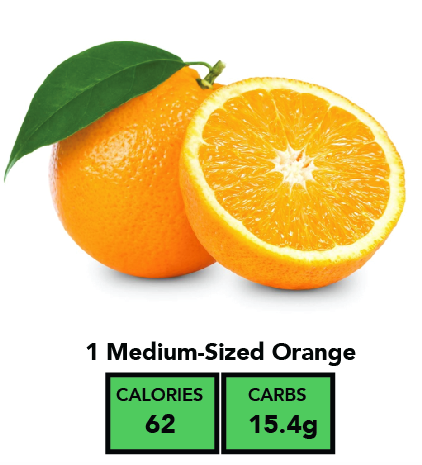
The orange is lower in calories and will fill you up a lot better than the orange juice would.
One 500ml bottle of orange juice is the same number of calories as four medium-sized oranges. Which one is going to fill you up more?
• ‘Diet/low-calorie foods and protein-infused products and bars.
There’s nothing inherently wrong with ‘diet’ products. In fact, they can be great additions to your diet during a low-calorie period.
The problem is when people assume they can eat as much of these as they like because ‘diet foods’. Those calories may be diet calories, but they’re still calories and they still count.
Secondly, you see all those ‘protein-infused’ products you’re seeing everywhere these days?
Well. Take a look at these two images.
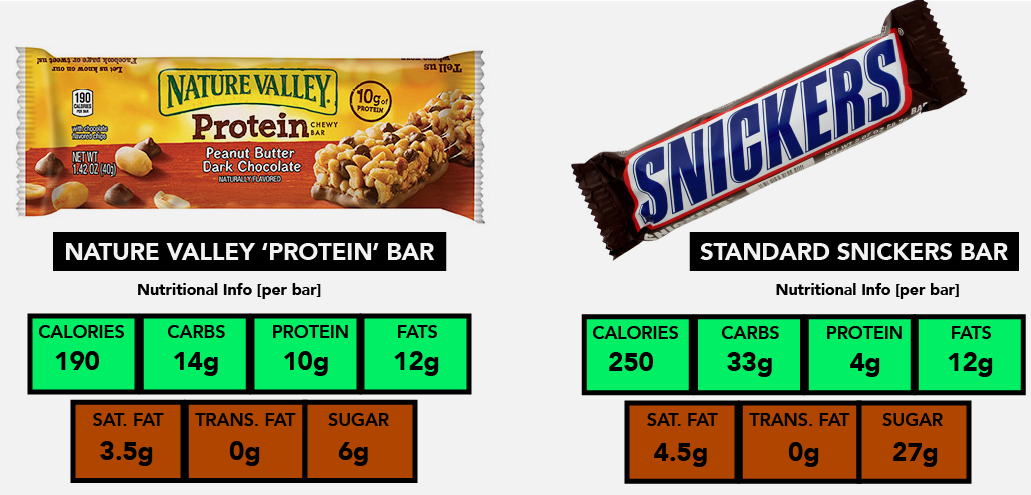
On the left, you have a popular ‘health’ bar and on the right, you have the tastiest chocolate bar on the damn planet.
At first glance the Nature Valley bar does seem better, right? Lower in calories, has more protein, has less sugar.
Not so fast, mi amigo. Let’s really take a look at these.
Calories: 190 versus 250. Not that much of a difference (60 cals) for an ostensible ‘health’ bar versus a ‘bad’ chocolate bar.
fat intake: Is equal between the two.
Protein: Sure some may argue the nature valley bar has more protein, but remember the context–the snickers bar is not being advertised as a ‘high protein’ product, it’s a standard chocolate bar. Nature Valley is promoting its product as a ‘high protein’ item. When viewed in this context, 6g of protein isn’t that big of a difference.
Also, If you’re going to claim an item as high protein, you’d imagine protein making up a dominant percentage of total calories, no?
Well…
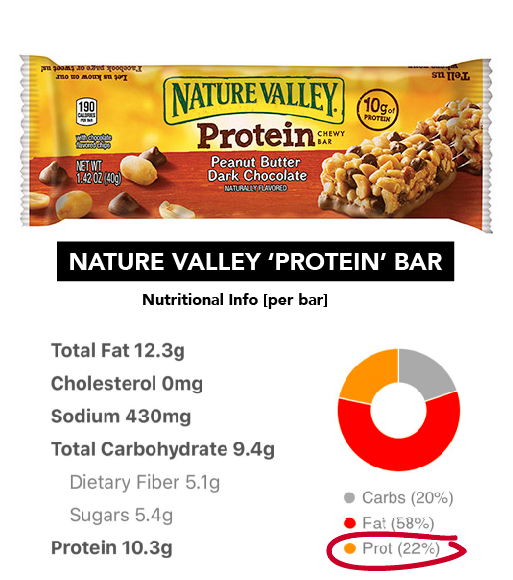
Protein only makes up 22% of total calories, while fat makes up more than half. Not sure about you guys, but based on the numbers, I’d say having ‘Fat’ plastered on the front of the package would be more fitting.
If we were to compare this to the currently popular Grenade protein bars:
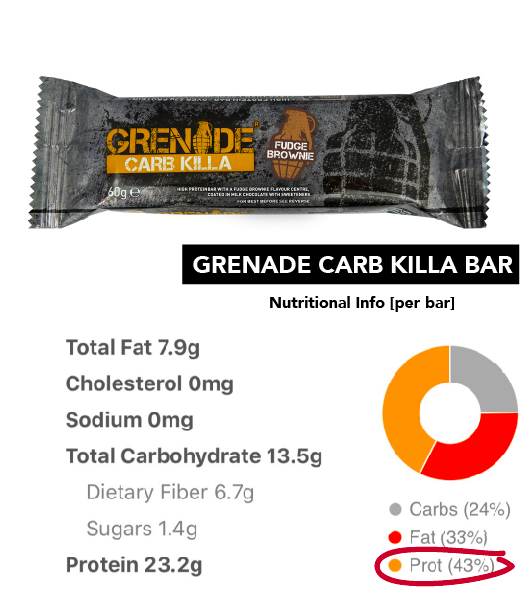
43% of the total calories are derived from protein. See the difference?
No, Grenade didn’t pay me to say this. However, if anyone from Grenade reads this, I’m more than happy to accept a lifetime supply of free Grenade bars for the free publicity I just gave your shit. You’re welcome.
Oh, c’mon, you’re being pedantic.
Am I, really? Ok. Let’s see. One Nature Valley bar may be fewer calories and could make for a good replacement for the Snickers bar during a diet.
But, you see, the Health Halo Effect kicks in and people assume that because the Nature Valley bar is ‘healthy’, they can eat more without worrying about calories: two or three of those Nature Valley bars in a day can add up to more than 500 calories. That’s more than enough to start gaining a pound of fat over a week.
Most of these quote-unquote marketed protein products are nothing more than glorified chocolate bars. And if you aren’t consciously paying attention to these things, the calories can add up very quickly.
• Organic Foods
Ah yes. The golden child of the food industry: organic produce. Even though studies have shown that organic food doesn’t have any additional health benefits versus conventional, people still assume that eating organic is not only better but also, somehow, makes them immune to the calorie law.
No, really. When a food item is labelled organic, people assume it has fewer calories than a non-organic counterpart–and this is the really trippy bit– even when they’re told both products contain the same amount of calories.
Please understand that ‘healthy’ is not synonymous with ‘calorie-free’. Healthy foods should be a staple in everyone’s diet but within the overarching context of calorie control.
In this article by the New York Times, the American public were asked their opinions on foods they deemed ‘healthy’; take a look at this chart they posted. 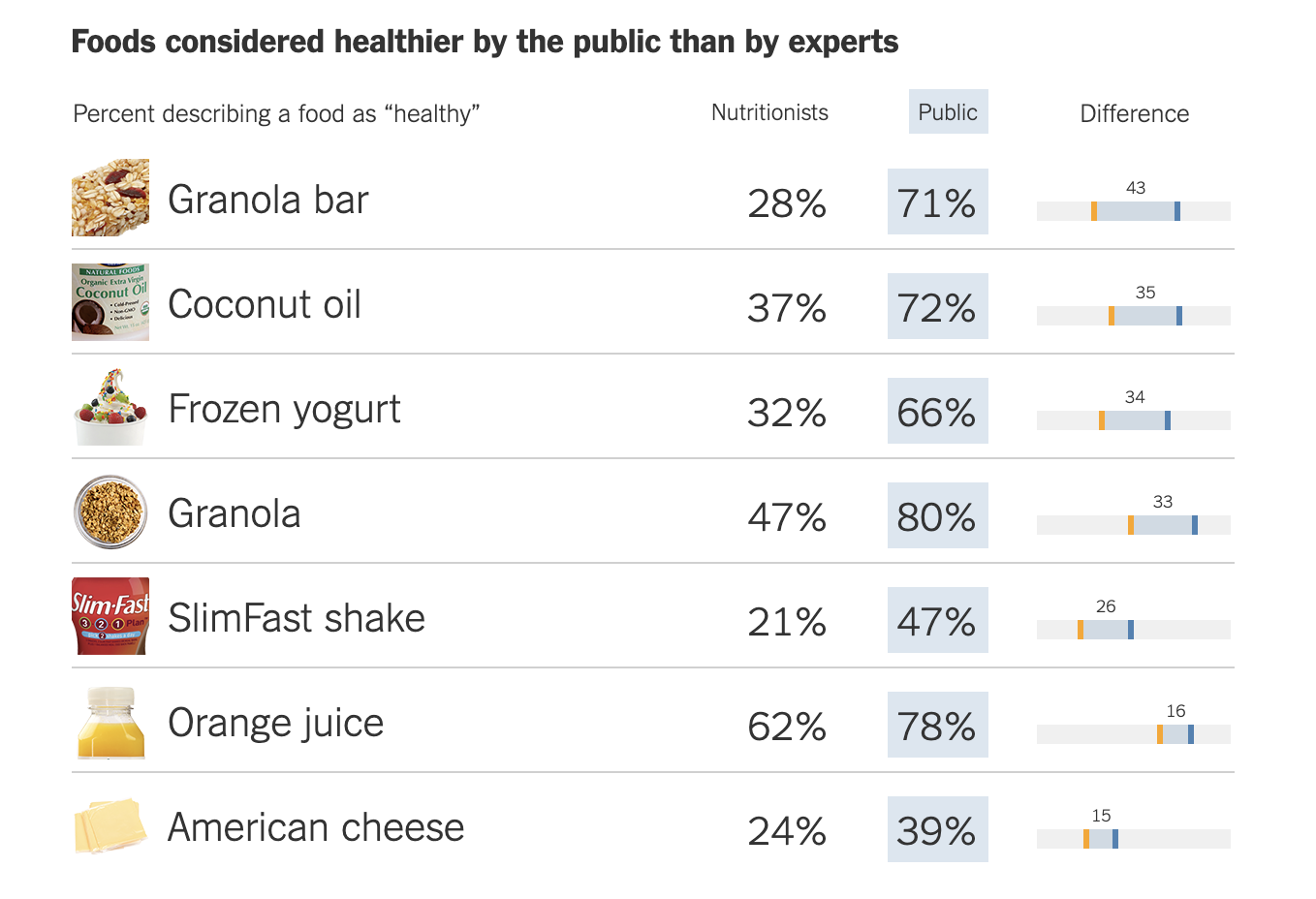
Granola bar topped the list, and even orange juice is in there. See what I mean? Once again, most people do pay attention to the types of food they’re eating, it’s the ‘how much’ of these foods they’re eating that’s the problem.
We forget what we’ve eaten.
Do you remember what you had for breakfast? Really, are you sure that what you think you had for breakfast today isn’t really what you had for breakfast yesterday? Talking of which, do you remember everything you ate yesterday? The day before?
Point: we’re not very good at remembering what we’ve eaten. This leads to eating more than we think we did.
Larger portions make us eat more
Take a look at these two bowls.
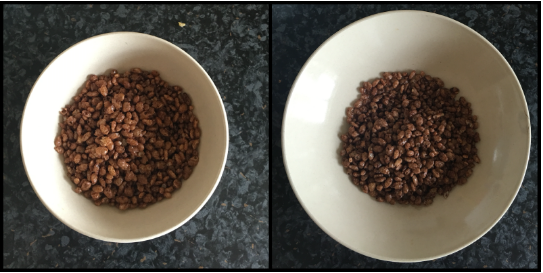
Which bowl contains more cereal?
If you guessed left, you’re wrong. Oh, you picked the right bowl, huh? You’re wrong too.
They both contain the same amount: 25g
This illustrates the illusion of portion size: Larger portions make us eat more.
Solution: serving foods with smaller plates may reduce the amount of food you eat and decrease calorie intake.
Mindless Eating
How many people keep ‘snacks’ at their office desk? Quite a few I’d imagine.
A few pieces of fruit here and there. One or two handfuls of nuts to stave off hunger until lunch. Ah, it’s the dreaded mid-afternoon crash–time for that ‘healthy’ granola bar. All these small things we think are harmless, add up.
Let me give you an example.
One of the common ‘snack’ foods found on office desks is nuts.
This is an actual 25g serving of brazil nuts.
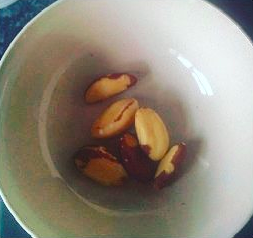
See how tiny it is? This 25g serving comes in at 165 calories and 16.6g of fat.
If you kept a 100g bag of Brazil Nuts at your desk, snacking on them throughout the day, by the end of your working day: you’ve just consumed 656 calories and 67g of fat.
That’s more calories than two Snickers bars.
This is on top of breakfast, lunch, dinner, and any other snacks you had. We also tend to eat more when we have food within easy reach and because we’re also working, we seldom notice ourselves doing this. And even if we do notice, remember the whole being bad at remembering what we ate?
Solution: Don’t keep snacks around your desk while working. If you do want to grab a snack, make sure it’s kept in the office kitchen. The simple act of making it harder to get to will reduce the chances of mindless eating.
Hidden Calories
Hidden calories are all the calories we don’t think about because we don’t really expect them to be there, or underestimate the impact they can have on total calorie intake.
• Restaurants
When you go out to eat at restaurants, there are a lot of hidden calories you either forget to think about or simply don’t realise are there.
The oils they use in preparing the food, the sauces that accompany the food, the sugars and fats they add into the marinade.
The chef isn’t thinking about your waistline as much as he is your taste buds. All of these things add up, regardless if you realise or not.
Solution: As Dr Yoni Freedhoff recommends: ‘Add 40 percent to non-posted calorie counts for meals at restaurants, and 20 percent to posted information (since studies have shown that restaurants often undervalue the actual calorie content of their foods).’
• Fast food restaurants
Here’s a secret. You see the calories fast food places like subway post on their site and you find in your calorie app? They don’t include the sauces, cheeses, and any other condiments or additional things you get on your sub (unless explicitly stated, e.g. steak and cheese).
The tuna sub? What’s the tuna mixed with? Mayonnaise. A fuck ton of mayonnaise.
This adds up.
Allow me to show you.
This is the recommended serving of mayonnaise, 14g (just under 1 tbsp).
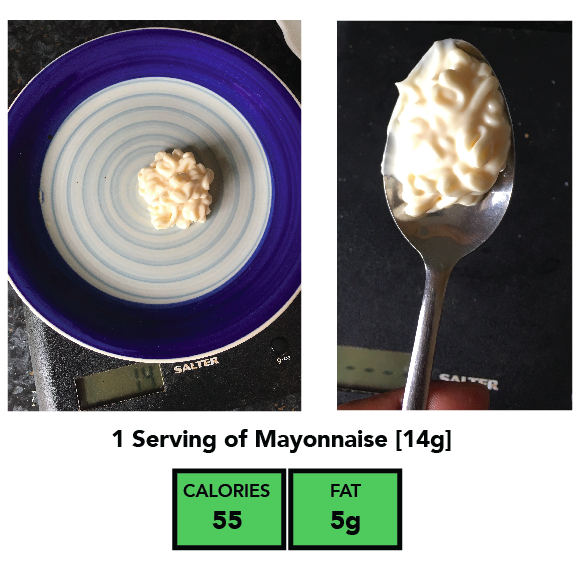
See how small it is? One serving comes in at 5g of fat. Restaurants aren’t going to weigh out mayonnaise before they pour it into their dish. And these calories add up very, very fast without you realising.
Solution: Keep a tab on the extra toppings you’re getting.
• The cinema
Oh, you know that large tub of popcorn you ate at your last visit to the cinema?

Surprised? Don’t worry: so were all these people.
Solution: Ditch the movie snacks. Seriously, what are you, 12? Not eating popcorn isn’t going to impact your enjoyment of the movie – and if the movie sucked, won’t make it suck any less. But, If you simply can’t live without a snack during the movie, factor the calories into your daily total. This could mean skipping dessert if you go out for a meal beforehand.
• Salads
Oh c’mon, salads are healthy. DON’T TELL ME SALADS AREN’T HEALTHY.
The salad part of a salad is healthy, the other part–Caesar, Greek, or whatever exotic sounding country you wish to name your salad after to make it seem healthy–not so much. Most of the salads you find at restaurants tend to come with additional toppings: cheese, mayo, oil.
And it’s these additional toppings that see this humble low-calorie starter or side become a Frankensteinian calorie-rich dish.
On average, for a Caesar Salad, you’re looking at anywhere from 250-400 calories. This can be much higher if you go to one of those swanky high-end fancy pants restaurants.
Solution: Pay attention. Don’t assume just because it’s called a salad, it’s zero-calorie and healthy. Most restaurants have the ingredients listed in the menu, check the salad to make sure there aren’t any extra toppings. If there are you can factor these into your calorie count for the day or simply ask the restaurant not add these when they make your food – remember, you’re paying them.
• Just a ‘splash’ of cream and milk
That ‘splash’ of cream and/or milk in your coffee? It adds up, and because it’s liquid you end up pouring in more than you think you are.
One tablespoon of cream is 70 calories and 7g of fat. I’ll give you the benefit of the doubt and assume you actually are pouring 1 tbsp, you’re not, but I’ll play along. 3-4 cups of coffee in a day?
That’s between 210-280 calories and 21-28g of fat. You do this every day and in a week you’ve consumed an additional, unaccounted for, 1,960 calories.
Solution: If you lack the testicular fortitude to drink your coffee straight black, you know, how God intended, and you simply must ‘lighten’ the taste–stick to skim or low-calorie milk. But just keep an eye on how much you’re pouring in.
• Weight versus volume
This is common to see on food packaging: ‘1 tablespoon’, ‘1 scoop’, ‘1 cup’, etc.
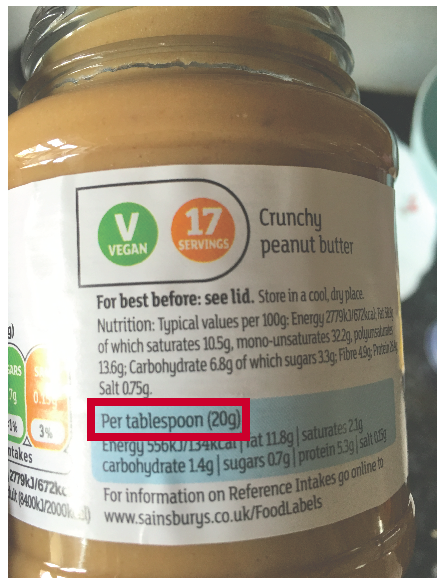
The problem is when you use volume as a way to measure food, it’s hardly accurate.
Look at the image below depicting two different servings of Peanut Butter: one was a ‘tablespoon’, and one was an actual 20g, weighed on a scale, serving.
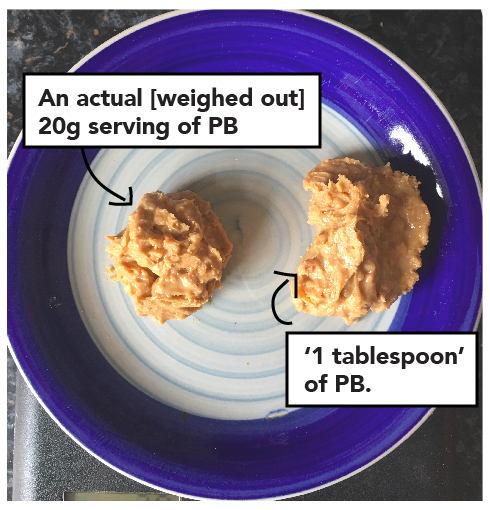
Looking at the two servings side by side, the difference is notable. But here are the numbers:
| Peanut Butter Serving | Calories | Fat |
|---|---|---|
| 20g weighed | 136 | 12g |
| 1 tablespoon | 292 | 25.7g |
And this is my point. When you go by volume you’re more likely than not to be way off from the actual serving size listed on the packaging.
Solution: Weigh out your food, even if it’s only for a little while at the start. This will help you better understand actual serving sizes and soon you’ll be able to make pretty accurate guesses.
It’s All Relative
One final point before we close up.
People forget this, but the impact of the amount you overeat will vary depending on your size–height, weight–and gender.
A 200lb man dieting on 2500 calories per day and overeating by 300 calories is only an increase of 13%, versus a 120 lb female dieting on 1100 calories and overeating by 300 calories, that’s a 27% increase.
A similar amount of calories, but depending on circumstance, it can be ‘meh, to ‘oh shit, I’m gaining weight in a deficit.
In Closing
HOLY FUCK. You actually just read to the end of a six-motherfucking-thousand-word article on calories and food. You, my friend, are no normal denizen of this beautiful blue sphere, you are in the top 1% of fucking crazy. Good job. Drop me an email and I’ll send you a free gift.
I hope that by reading this you now understand that the environment and our proclivity for making cognitive errors can lead us to overeat by a lot more than we think, even when we believe we’re being diligent.
This is why it’s important to have a basic understanding of calories and tracking food intake for a certain period of time.
It might not be as simple as calories in versus calories out, but calorie awareness is still our best defence against an obesogenic environment that encourages us to overeat.
Calorie tracking is a life skill that will eventually lead you to understand portion sizes, what an actual serving size of meals at your favourite restaurants looks like. You’ll soon be able to ‘eyeball’ or ‘guestimate’ calorie count of foods without having to track. But you have to start with the basics first.
P.S – There is no free gift. But thank you for reading. You might as well hit share seeing you’re here now.
Footnotes:
Calorie counts of foods from the beginning of the article:
– Medium Popcorn: 600 calories.
– Large pepperoni pizza (Domino’s): 2,370 calories.
– 1 tbsp PB: 94 calories.
– Grande Caffe Mocha (Starbucks): 250 calories (note this is without whipped cream and using non-fat milk – if you get cream and milk this could be almost double).
– Big Mac Meal: ~1000 calories.